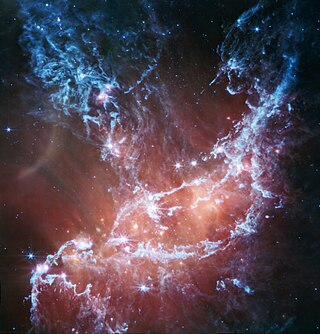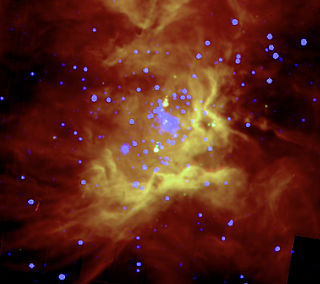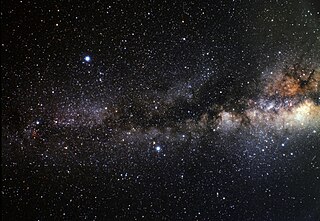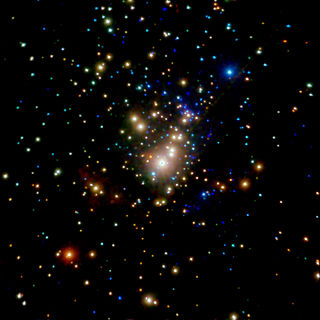
A molecular cloud, sometimes called a stellar nursery (if star formation is occurring within), is a type of interstellar cloud, the density and size of which permit absorption nebulae, the formation of molecules (most commonly molecular hydrogen, H2), and the formation of H II regions. This is in contrast to other areas of the interstellar medium that contain predominantly ionized gas.

Star formation is the process by which dense regions within molecular clouds in interstellar space, sometimes referred to as "stellar nurseries" or "star-forming regions", collapse and form stars. As a branch of astronomy, star formation includes the study of the interstellar medium (ISM) and giant molecular clouds (GMC) as precursors to the star formation process, and the study of protostars and young stellar objects as its immediate products. It is closely related to planet formation, another branch of astronomy. Star formation theory, as well as accounting for the formation of a single star, must also account for the statistics of binary stars and the initial mass function. Most stars do not form in isolation but as part of a group of stars referred as star clusters or stellar associations.

The Orion Nebula is a diffuse nebula situated in the Milky Way, being south of Orion's Belt in the constellation of Orion,[b] and is known as the middle "star" in the "sword" of Orion. It is one of the brightest nebulae and is visible to the naked eye in the night sky with apparent magnitude 4.0. It is 1,344 ± 20 light-years (412.1 ± 6.1 pc) away and is the closest region of massive star formation to Earth. The M42 nebula is estimated to be 24 light-years across. It has a mass of about 2,000 times that of the Sun. Older texts frequently refer to the Orion Nebula as the Great Nebula in Orion or the Great Orion Nebula.

The Rosette Nebula is an H II region located near one end of a giant molecular cloud in the Monoceros region of the Milky Way Galaxy. The open cluster NGC 2244 is closely associated with the nebulosity, the stars of the cluster having been formed from the nebula's matter.

The Trifid Nebula is an H II region in the north-west of Sagittarius in a star-forming region in the Milky Way's Scutum–Centaurus Arm. It was discovered by Charles Messier on June 5, 1764. Its name means 'three-lobe'. The object is an unusual combination of an open cluster of stars, an emission nebula, a reflection nebula, and a dark nebula. Viewed through a small telescope, the Trifid Nebula is a bright and peculiar object, and is thus a perennial favorite of amateur astronomers.

Sigma Orionis or Sigma Ori is a multiple star system in the constellation Orion, consisting of the brightest members of a young open cluster. It is found at the eastern end of the belt, south west of Alnitak and west of the Horsehead Nebula which it partially illuminates. The combined brightness of the component stars is magnitude 3.80.

The Flame Nebula, designated as NGC 2024 and Sh2-277, is an emission nebula in the constellation Orion. It is about 1350 light-years away. At that distance, the Flame Nebula lies within the Orion B cloud of the larger Orion Molecular Cloud Complex.
A super star cluster (SSC) is a very massive young open cluster that is thought to be the precursor of a globular cluster. These clusters called "super" because they are relatively more luminous and contain more mass than other young star clusters. The SSC, however, does not have to physically be larger than other clusters of lower mass and luminosity. They typically contain a very large number of young, massive stars that ionize a surrounding HII region or a so-called "Ultra dense HII region (UDHII)" in the Milky Way Galaxy or in other galaxies. An SSC's HII region is in turn surrounded by a cocoon of dust. In many cases, the stars and the HII regions will be invisible to observations in certain wavelengths of light, such as the visible spectrum, due to high levels of extinction. As a result, the youngest SSCs are best observed and photographed in radio and infrared. SSCs, such as Westerlund 1 (Wd1), have been found in the Milky Way Galaxy. However, most have been observed in farther regions of the universe. In the galaxy M82 alone, 197 young SSCs have been observed and identified using the Hubble Space Telescope.

Westerlund 1 is a compact young super star cluster about 3.8 kpc away from Earth. It is thought to be the most massive young star cluster in the Milky Way, and was discovered by Bengt Westerlund in 1961 but remained largely unstudied for many years due to high interstellar absorption in its direction. In the future, it will probably evolve into a globular cluster.

NGC 346 is a young open cluster of stars with associated nebula located in the Small Magellanic Cloud (SMC) that appears in the southern constellation of Tucana. It was discovered August 1, 1826 by Scottish astronomer James Dunlop. J. L. E. Dreyer described it as, "bright, large, very irregular figure, much brighter middle similar to double star, mottled but not resolved". On the outskirts of the cluster is the multiple star system HD 5980, one of the brightest stars in the SMC.

NGC 4449, also known as Caldwell 21, is an irregular Magellanic type galaxy in the constellation Canes Venatici, being located about 13 million light-years away. It is part of the M94 Group or Canes Venatici I Group that is relatively close to the Local Group hosting our Milky Way galaxy.
A color–color diagram is a means of comparing the colors of an astronomical object at different wavelengths. Astronomers typically observe at narrow bands around certain wavelengths, and objects observed will have different brightnesses in each band. The difference in brightness between two bands is referred to as color. On color–color diagrams, the color defined by two wavelength bands is plotted on the horizontal axis, and the color defined by another brightness difference will be plotted on the vertical axis.

The Serpens South star cluster is a relatively dense group of more than 600 young stars, dozens of which are protostars just beginning to form. The cluster is situated in the southern portion of the Serpens cloud. The stars are embedded in a dense filament of interstellar gas, which is part of the giant molecular cloud that has given rise to the cluster of young stars in W40. This entire complex is located at a distance of 1420 light-years from the Earth, and is approximately the same distance as the Serpens Main cluster.

IC 5146 is a reflection/emission nebula and Caldwell object in the constellation Cygnus. The NGC description refers to IC 5146 as a cluster of 9.5 mag stars involved in a bright and dark nebula. The cluster is also known as Collinder 470. It shines at magnitude +10.0/+9.3/+7.2. Its celestial coordinates are RA 21h 53.5m, dec +47° 16′. It is located near the naked-eye star Pi Cygni, the open cluster NGC 7209 in Lacerta, and the bright open cluster M39. The cluster is about 4,000 ly away, and the central star that lights it formed about 100,000 years ago; the nebula is about 12 arcmins across, which is equivalent to a span of 15 light years.

Westerhout 40 or W40 is a star-forming region in the Milky Way located in the constellation Serpens. In this region, interstellar gas forming a diffuse nebula surrounds a cluster of several hundred new-born stars. The distance to W40 is 436 ± 9 pc, making it one of the closest sites of formation of high-mass O-type and B-type stars. The ionizing radiation from the massive OB stars has created an H II region, which has an hour-glass morphology.

RCW 36 is an emission nebula containing an open cluster in the constellation Vela. This H II region is part of a larger-scale star-forming complex known as the Vela Molecular Ridge (VMR), a collection of molecular clouds in the Milky Way that contain multiple sites of ongoing star-formation activity. The VMR is made up of several distinct clouds, and RCW 36 is embedded in the VMR Cloud C.

The Serpens–Aquila Rift (also known as the Aquila Rift) is a region of the sky in the constellations Aquila, Serpens Cauda, and eastern Ophiuchus containing dark interstellar clouds. The region forms part of the Great Rift, the nearby dark cloud of cosmic dust that obscures the middle of the galactic plane of the Milky Way, looking inwards and towards its other radial sectors. The clouds that form this structure are called "molecular clouds", constituting a phase of the interstellar medium which is cold and dense enough for molecules to form, particularly molecular hydrogen (H2). These clouds are opaque to light in the optical part of the spectrum due to the presence of interstellar dust grains mixed with the gaseous component of the clouds. Therefore, the clouds in the Serpens-Aquila Rift block light from background stars in the disk of the Galaxy, forming the dark rift. The complex is located in a direction towards the inner Galaxy, where molecular clouds are common, so it is possible that not all components of the rift are at the same distance and physically associated with each other.

Embedded stellar clusters, or simply embedded clusters (EC), are open clusters that are still surrounded by their progenitor molecular cloud. They are often areas of active star formation, giving rise to stellar objects that have similar ages and compositions. Because of the dense material that surrounds the stars, they appear obscured in visible light but can be observed using other sections of the electromagnetic spectrum, such as the near-infrared and X-rays that can see through the cloud material. In the Milky Way Galaxy, embedded clusters can mostly be found within the Galactic disk or near the Galactic Center where most of the star-formation activity is happening.

NGC 3256 is a peculiar galaxy formed from the collision of two separate galaxies in the constellation of Vela. NGC 3256 is located about 100 million light-years away and belongs to the Hydra–Centaurus Supercluster complex. NGC 3256 provides a nearby template for studying the properties of young star clusters in tidal tails. The system hides a double nucleus and a tangle of dust lanes in the central region. The telltale signs of the collision are two extended luminous tails swirling out from the galaxy. The tails are studded with a particularly high density of star clusters. NGC 3256 is the most luminous galaxy in the infrared spectrum located within z 0.01 from Earth.

















